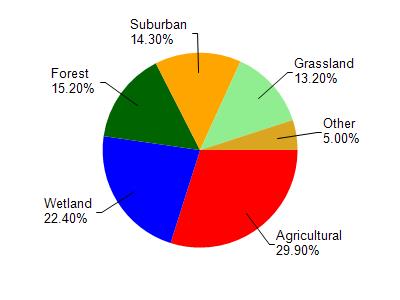Waukesha
No
No
No
Fish and Aquatic Life
Overview
Middle Genesee Lake is hydraulically connected to the Upper Genesee Lake and exhibits similar lake level fluctuations. There are an estimated 53 homes on the lake that experience septic flooding problems, eight of which are in a recent subdivision. Development around the lake must account for the system's rapidly fluctuating water levels. The U.S. Geological Survey is studying the lake to manage for the high water levels. A Lakes Planning Grant could provide funds for a plan to incorporate the results of the USGS water level investigation. The planning grant could help identify specific septic system problems and potential wetland impacts from managing the lake's water level to avoid septic system flooding.
Date 2002
Author Aquatic Biologist
Historical Description
Source: 1963, Surface Water Resources of Waukesha County Middle Genesee Lake T7N, R17E, Sections 21 and 22 Surface-Acres = 102, S. D. F. = 1. 13, Maximum Depth = 3 8 feet.
A landlocked basin in outwash deposits; previously connected to Lower Genesee Lake. An area of shallow marsh to the northeast is currently ditched to the lake. The water is clear and most of the bottom is sand or gravel. The fishery consists of pan fish and largemouth bass. Access is possible from a town road, however, parking is inadequate. Swimming from the roadway has been prohibited by the town.
Date 1963
Author Surface Water Inventory Of Wisconsin
General Condition
Middle Genesee Lake (778300) was assessed during the 2016 listing cycle; total phosphorus and chlorophyll sample data were clearly below Fish and Aquatic Life use listing thresholds. This water is meeting this designated use and is not considered impaired.
Date 2015
Author Ashley Beranek
Condition
Wisconsin has over 84,000 miles of streams, 15,000 lakes and milllions of acres of wetlands. Assessing the condition of this vast amount of water is challenging. The state's water monitoring program uses a media-based, cross-program approach to analyze water condition. An updated monitoring strategy (2015-2020) is now available. Compliance with Clean Water Act fishable, swimmable standards are located in the Executive Summary of Water Condition in 2018. See also the 'monitoring and projects' tab.
Reports
Recommendations
Lakes Planning Grant
Middle Genesee Lake should receive a lakes planning grant to develop a plan that incorporates the results of the recent U.S. Geological Survey water level investigation; the planning grant would identify specific septic problems and potential wetland impacts from managing the lake's water level to avoid flooding the septic systems.
Management Goals
Wisconsin's Water Quality Standards provide qualitative and quantitative goals for waters that are protective of Fishable, Swimmable conditions [Learn more]. Waters that do not meet water quality standards are considered impaired and restoration actions are planned and carried out until the water is once again fishable and swimmable
Management goals can include creation or implementation of a Total Maximum Daily Load analysis, a Nine Key Element Plan, or other restoration work, education and outreach and more. If specific recommendations exist for this water, they will be displayed below online.
Monitoring
Monitoring the condition of a river, stream, or lake includes gathering physical, chemical, biological, and habitat data. Comprehensive studies often gather all these parameters in great detail, while lighter assessment events will involve sampling physical, chemical and biological data such as macroinvertebrates. Aquatic macroinvertebrates and fish communities integrate watershed or catchment condition, providing great insight into overall ecosystem health. Chemical and habitat parameters tell researchers more about human induced problems including contaminated runoff, point source dischargers, or habitat issues that foster or limit the potential of aquatic communities to thrive in a given area. Wisconsin's Water Monitoring Strategy was recenty updated.
Grants and Management Projects
Monitoring Projects
| WBIC | Official Waterbody Name | Station ID | Station Name | Earliest Fieldwork Date | Latest Fieldwork Date | View Station | View Data |
|---|
| 778300 | Middle Genesee Lake | 10007211 | Middle Genesee Lake | 6/1/1995 | 9/30/2017 | Map | Data |
| 778300 | Middle Genesee Lake | 683449 | Middle Genesee Lake - Near Oconomowoc WI | 7/12/2024 | 7/12/2024 | Map | Data |
| 778300 | Middle Genesee Lake | 10017606 | Middle Genesee Lake -- Access | 5/23/2006 | 8/23/2025 | Map | Data |
| 778300 | Middle Genesee Lake | 10021959 | Middle Genesee Lake | 7/31/2019 | 7/31/2019 | Map | Data |
| 778300 | Middle Genesee Lake | 10045547 | Phragmites Occurrence - Middle Genesee Lake | | | Map | Data |
| 778300 | Middle Genesee Lake | 683253 | Middle Genesee Lake - Deepest Spot | 9/18/1980 | 9/13/2017 | Map | Data |
|

Watershed Characteristics
Middle Genesee Lake is located in the Bark River watershed which is 185.84 mi². Land use in the watershed is primarily agricultural (29.90%), wetland (22.40%) and a mix of forest (15.20%) and other uses (32.50%). This watershed has 265.69 stream miles, 3,499.26 lake acres and 22,145.94 wetland acres.
Nonpoint Source Characteristics
This watershed is ranked Medium for runoff impacts on streams, High for runoff impacts on lakes and High for runoff impacts on groundwater and therefore has an overall rank of High. This value can be used in ranking the watershed or individual waterbodies for grant funding under state and county programs.However, all waters are affected by diffuse pollutant sources regardless of initial water quality. Applications for specific runoff projects under state or county grant programs may be pursued. For more information, go to surface water program grants.